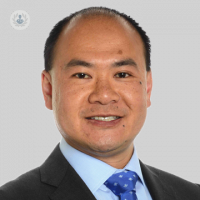Can your smart watch detect atrial fibrillation?
Written by:Around 2.5 per cent of patients in the UK, approximately 1.5 million individuals, currently live with and have a diagnosis of atrial fibrillation, making it the most common heart rhythm disorder. Simplistically, it's a condition whereby the rhythm of the top chambers, the atria, becomes disorganised which leads to a faster and more irregular heartbeat. This can lead to a number of symptoms because the heart becomes less efficient in pumping blood, such as breathlessness, palpitations, tiredness and lethargy. It can also increase the risk of blood clots and strokes. To give expert insight on this condition, leading consultant cardiologist Dr Fu Siong Ng explains how atrial fibrillation is diagnosed and treated.

How is atrial fibrillation diagnosed?
In order to make a diagnosis of atrial fibrillation, we need to record the electrical activity of the heart to show that this is behind the patient’s irregular heart rhythm. At a simpler level, however, you can pick up atrial fibrillation just by checking your pulse. By feeling your pulse at the wrist, you will be able to observe if it is regular or irregular and GPs or family doctors will often do that as the first line of diagnosis.
If there is any suspicion that the pulse is irregular, we can confirm a diagnosis of atrial fibrillation performing a scan called an ECG or electrocardiogram, which measures the electrical activity of the heart using little stickers and electrodes on the surface of the chest. There are also other ways this can be assessed, including by wearing a heart monitor that has a smaller number of leads. This can be worn from twenty-four hours to as long as two weeks to monitor the heart rhythm and pick up any irregularity.
Finally, with the expansion of wearable technology, this can now also be picked up by smart watches, such as an Apple Watch or a Fitbit which can detect irregularities in the heart’s rhythm. Many of our patients now come to us through an alert from their smart watch that tells them they have atrial fibrillation and then we confirm that using an ECG.
What causes atrial fibrillation?
The causes of atrial fibrillation are often multi-fold. There isn't a single direct cause that leads to the condition but rather a combination of factors. This includes some things that you can't control, such as your age and your genetics, combined with other factors that you can control, including your weight, alcohol consumption, exercise activity and other conditions like high blood pressure. Although there are many factors that are at play, a patient can try to address a good many of them.
How is atrial fibrillation treated?
There are a two key considerations when treating a patient with atrial fibrillation; reducing risk and treating symptoms.
Firstly, we want to reduce the risk of blood clots and strokes because atrial fibrillation predisposes to these complications. The vast majority of patients will be prescribed a blood thinner medication which makes the blood less sticky and less likely to clot, reducing the chances of them having a stroke going forward. Although some young and otherwise healthy patients may not need this medication, the majority of patients will require it to continue living well.
The second consideration is to help the patient with their symptoms. These can include:
- palpitations
- breathlessness
- tiredness
- fatigue
- awareness of a fast heart rate
At the very lowest level, we can prescribe some medications to control and slow the heart rate which ensures the patient is less symptomatic and has fewer troubling symptoms. We could also give medications to try and reset a normal heart rhythm using antiarrhythmic drugs.
The next line in treating symptoms is to do something physical to reset the heart rhythm, such as performing a cardioversion. This is a very minor procedure completed under general anaesthetic, where a single electrical shock is delivered through the heart muscle using two pads placed across the chest. This resets the electrics of the heart and brings them back to normal.
The final step in treatment is called catheter ablation. This is a minimally invasive, keyhole procedure where we put little tubes, or catheters, into a vein in the leg and pass them up to the heart. Then we perform ablation, which is controlled destruction of heart muscle by either heating or cooling the heart muscle to modify what's going on in the atria to reduce the likelihood of it coming back.
Depending on the severity of the patient’s symptoms, their medical history and the likelihood of success of the treatments, a treatment plan is made in discussion between the individual and their doctor.
Can atrial fibrillation be prevented?
There are several things that a patient can do to avoid atrial fibrillation as the risk of developing the condition is increased by some lifestyle choices and other factors. Factors that make a person more likely to develop the condition include:
- being overweight
- high consumption of alcohol
- suffering from a sleep disorder
To avoid atrial fibrillation, you can treat what we call the risk factors of atrial fibrillation. If you're overweight, reaching a healthier weight lessens the risk of developing the condition, as does moderating your consumption of alcohol to be within the normal limits. Increasing exercise and activity also helps you to be fitter and to reduce your risk. If you have any sleep disorders like sleep apnoea, it’s important to get effective treatment. This also applies to conditions such as high blood pressure, as these are predisposing factors.
How can patients with atrial fibrillation manage their condition?
In conversation with your practitioner, an effective care plan should be established to both reduce the risk of serious events, such as strokes, and to reduce symptoms in a way that poses the lowest risk to the patient. A careful choice must be made about the right level of treatment, be it medication, cardioversion or ablation.
Following this, it is key that the patient takes some ownership of the disease by doing what they can to reduce the likelihood of progression. Atrial fibrillation can progress from a paroxysmal form, where it is intermittent, to the persistent form which is always present. The patient can take steps to modify their lifestyle and weight, treating any other conditions like high blood pressure, exercising more and reducing alcohol consumption. This whole package is informed by a very close dialogue between the patient and the physician over the course of many years to help them to continue to live a very fulfilling life with atrial fibrillation.
If you are concerned about your heart health or are seeking treatment for atrial fibrillation, you can book a consultation with Dr Ng and learn more about him by visiting his Top Doctors profile.


